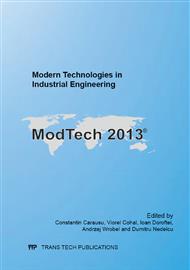p.105
p.110
p.116
p.122
p.128
p.135
p.141
p.147
p.152
Influence of Cutting Parameters on the Surface Quality of Round Parts Made from AZ61 Magnesium Alloy and Machined by Turning
Abstract:
The use of magnesium alloys in construction of different components of the mechanical systems (such: cars, aerospace vehicles, medical equipment etc.) is very efficient not only because it leads to reduction of the systems weight but also because it leads to reduction or elimination of the environment polluting and to reduction of the energy consumption. Generally, the main factors that influence the quality of the machined surfaces are as follows: cutting parameters, material properties, geometry of the tools, cooling liquids and lubricants, physical and mechanical properties of the subsurface layers etc. Among the above mentioned factors, cutting parameters are the factors that strongly influence the quality of the machined surfaces. The present paper analysis the results of the experimental investigation performed to determine the influence of cutting parameters (cutting speed, feed rate and cutting depth) on the surface quality machined by turning the AZ61 magnesium alloy. The main characteristics of the machined surface quality analyzed in experimental investigation were the surface roughness and hardness. The main conclusions resulted from the results analysis were as follows: the decrease of the feed rate led to surface roughness decrease and hardness increase; the increase of the cutting speed also led to an improved surface quality.
Info:
Periodical:
Pages:
128-134
Citation:
Online since:
November 2013
Authors:
Keywords:
Price:
Сopyright:
© 2014 Trans Tech Publications Ltd. All Rights Reserved
Share:
Citation:


